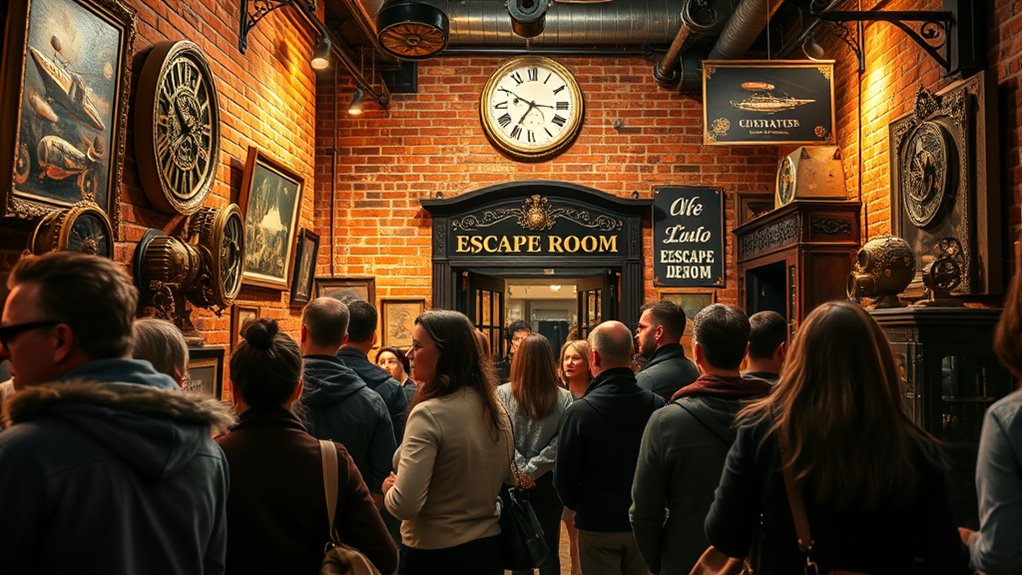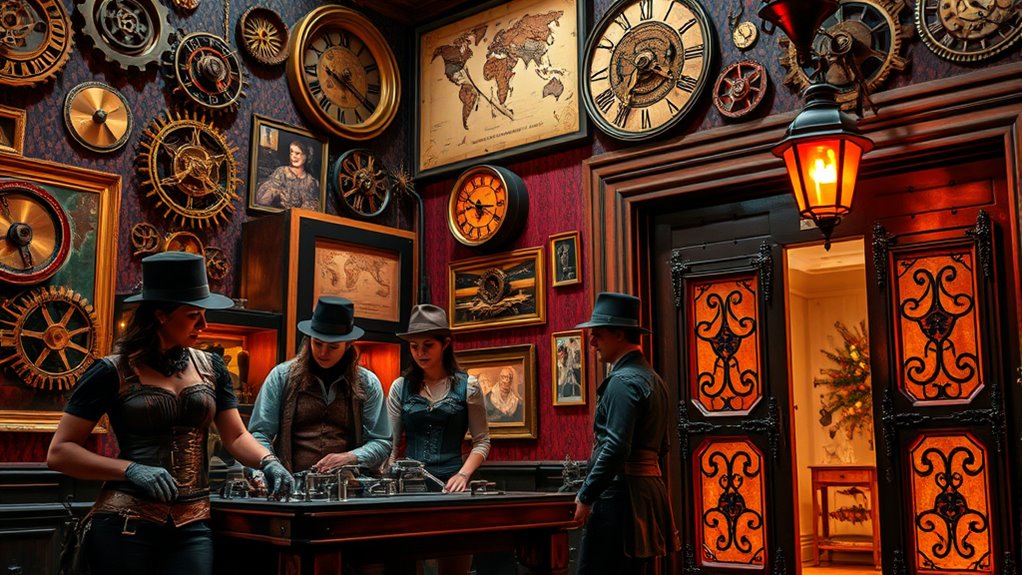Steampunk’s cultural footprint is widespread, influencing art galleries, fashion, and design with its blend of Victorian elegance and industrial innovation. You’ll find immersive escape rooms, featuring brass fittings, gears, and vintage-inspired puzzles that transport you to an alternative history. Its impact extends to movies, literature, and multimedia storytelling, creating a vibrant community that celebrates nostalgia and creativity. To discover how this unique movement shapes various creative outlets, explore further.
Key Takeaways
- Steampunk influences contemporary art galleries through themed exhibits blending Victorian aesthetics with industrial design.
- It shapes immersive escape rooms that recreate Victorian laboratories and airship decks with clockwork puzzles.
- The genre inspires fashion, storytelling, and multimedia projects, fostering a community of creative expression and cultural identity.
- Steampunk’s visual style and narratives appear in movies, literature, and video games, enhancing storytelling depth and aesthetic appeal.
- It prompts reflection on alternative technological and societal development paths, enriching cultural discourse and innovation.

Steampunk, a vibrant blend of Victorian aesthetics and industrial innovation, has carved out a distinctive space in contemporary culture. You might notice its influence in fashion, design, and storytelling, where Victorian fashion often inspires intricate corsets, waistcoats, and goggles combined with gears and metal accents. This unique style transports you to an alternative history where steam-powered machinery dominates daily life, blending the elegance of the past with a futuristic twist. As you explore steampunk-inspired art galleries or attend conventions, you realize how deeply this aesthetic has permeated creative expressions, shaping a community that celebrates both nostalgia and innovation.
In these spaces, Victorian fashion becomes more than just clothing; it transforms into a statement of identity and rebellion against modern minimalism. You can see enthusiasts sporting top hats, lace gloves, and leather accessories, all adorned with steampunk motifs. These outfits aren’t just costume—they’re a way to embody an alternative history where technology and Victorian elegance coexist seamlessly. This alternative history isn’t just a backdrop; it’s a lens through which creators imagine new worlds, stories, and possibilities. It invites you to question the linear progression of technology and consider what might have been if steam had continued to fuel progress instead of electricity or digital innovations.
Beyond galleries and conventions, steampunk’s influence extends into interactive experiences like escape rooms. Here, you’re immersed in environments that mimic Victorian laboratories or airship decks, complete with brass fittings, blinking gauges, and clockwork mechanisms. These settings challenge you to solve puzzles that feel rooted in a bygone era’s ingenuity, blending storytelling with hands-on engagement. As you work through clues, you’re not just playing; you’re stepping into an alternative history, experiencing a world where steam-powered devices are the norm and Victorian fashion sets the tone for adventure.
This cultural footprint also manifests in movies, literature, and even video games, where steampunk elements add depth and visual flair. You recognize how this aesthetic fosters community and creativity, inviting you to reimagine history with a twist. It’s not just about looking vintage; it’s about embracing a vision of the past that sparks your imagination and challenges your perceptions of technological progress. Whether through art, entertainment, or interactive experiences, steampunk continues to influence and inspire, cementing its place as a vibrant, enduring facet of contemporary culture.
Additionally, the history of technological innovation within steampunk narratives often prompts reflection on alternative pathways of progress and societal development.
Frequently Asked Questions
How Did Steampunk Originate Historically?
You might find it interesting that steampunk originated as a genre blending Victorian innovation with futuristic ideas. It draws on the mechanical symbolism of 19th-century technology, imagining an alternate history where steam power dominates. Originating in the 1980s, steampunk combines science fiction with historical aesthetics, celebrating Victorian-era design and innovation. This creative movement has grown from niche literature to a vibrant cultural phenomenon, inspiring art, fashion, and entertainment worldwide.
What Materials Are Commonly Used in Steampunk Fashion?
Imagine a wardrobe where Victorian textiles and leather dance with metal embellishments, creating a symphony of industrial elegance. In steampunk fashion, you’ll find materials like leather, brass, copper, and clockwork gears. Victorian fabrics, such as brocade and velvet, add richness, while metal accents like goggles and gears bring a rugged, inventive spirit. You become a walking demonstration to a world where Victorian sophistication meets industrial innovation.
Are There Steampunk Festivals Worldwide?
You’ll find steampunk festivals all around the world, where cosplay communities gather at themed conventions to celebrate the genre. These festivals showcase elaborate costumes, interactive exhibits, and performances inspired by Victorian-era technology and adventure. From the United States to Europe and Asia, each event offers a unique experience, immersing attendees in steampunk’s creative universe and allowing you to connect with fellow enthusiasts who share your passion for this imaginative style.
How Does Steampunk Influence Modern Technology Design?
You see how steampunk influences modern technology design through its retro-futuristic innovation, blending Victorian aesthetics with advanced mechanics. Like cyberpunk parallels, it inspires designers to incorporate intricate details and vintage elements into contemporary gadgets. By embracing this unique style, you can create technology that feels both nostalgic and futuristic, encouraging creative experimentation that pushes boundaries while honoring craftsmanship and historical inspiration.
Can Beginners Easily Create Steampunk-Inspired Art?
Diving into steampunk-inspired art is like opening a treasure chest of creativity—you just need the right map. As a beginner, you can definitely craft stunning DIY projects with simple tools and materials. Follow beginner tips like starting with basic gears, brass accents, and Victorian motifs to build your confidence. Remember, the key is to experiment and embrace imperfections—every steampunk masterpiece begins with a single imaginative step.
Conclusion
You might be surprised to learn that steampunk conventions have grown by over 150% in the last five years, showing just how deeply this retro-futuristic genre has embedded itself in mainstream culture. From art galleries to escape rooms, its influence keeps expanding, inviting more enthusiasts to embrace Victorian aesthetics with a modern twist. This rapid growth highlights steampunk’s power to inspire creativity and bring together diverse communities, proving that a love for the past can shape the future in unexpected ways.









